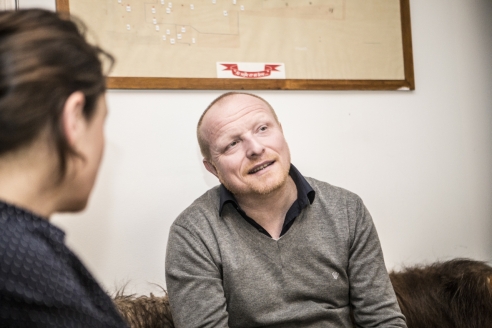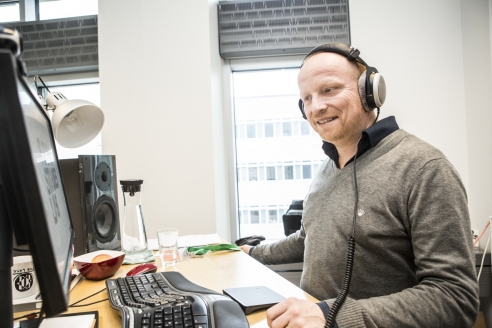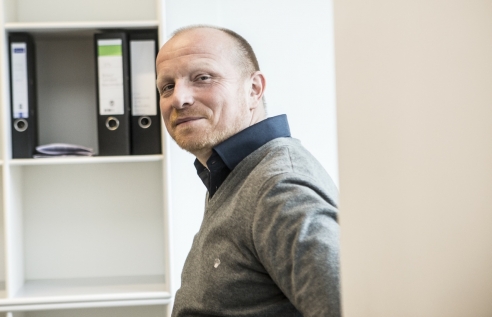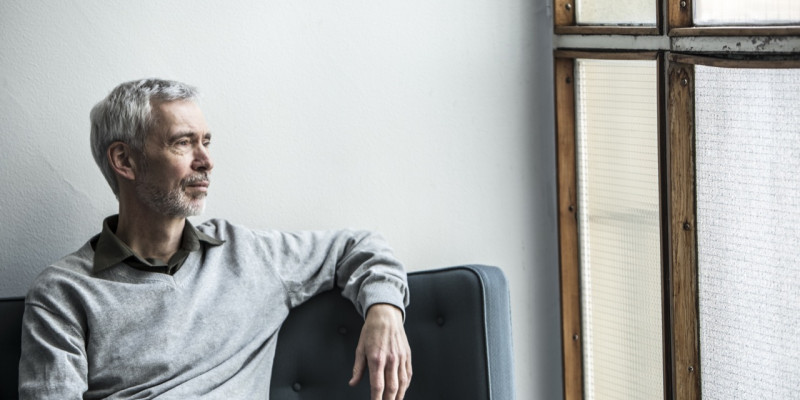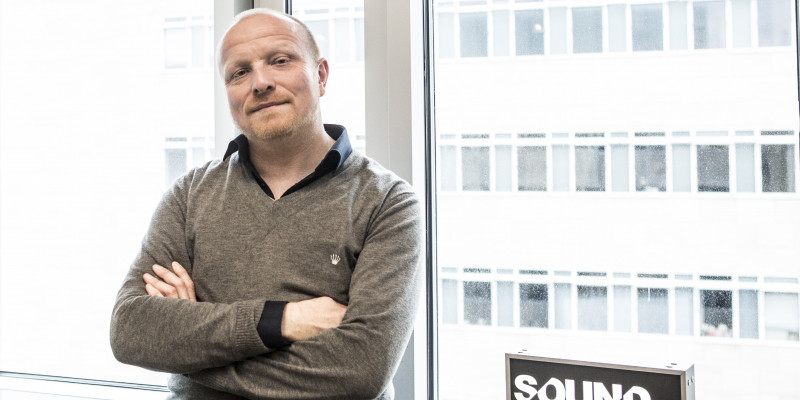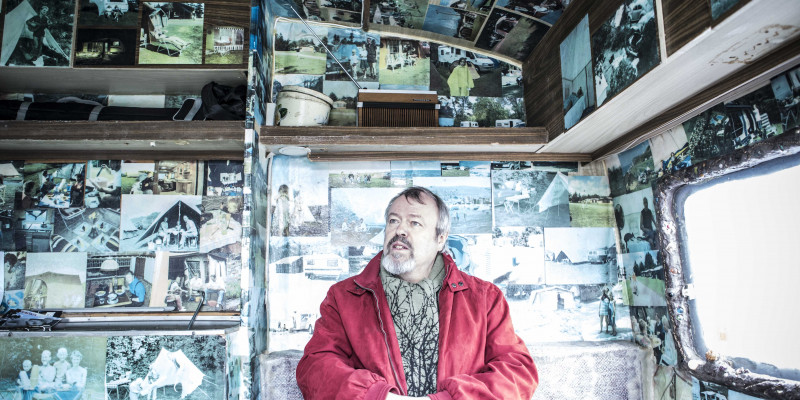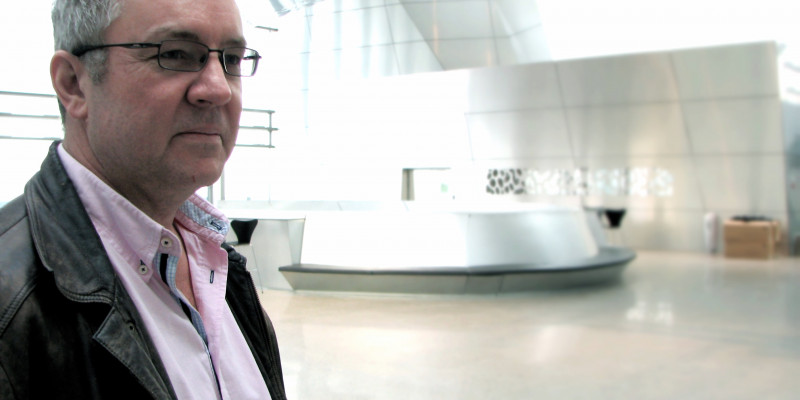
An anthropologist of sound
Det første i rækken er et interview med tyske Holger Schulze, der kommer fra Berlin, og netop er tiltrådt som professor ved Musikvidenskab på Institut for Kunst og Kulturvidenskab, Københavns Universitet. Hans forskningsområde afgrænses af overskriften ”sound studies”, hvor han beskæftiger sig med lyd og lyds betydning i både det hverdagslige og det kunstneriske. Han er desuden leder af det internationale forskningslaboratorium Sound Studies Lab, og er tilknyttet som kurator for Haus der Kulturen der Welt i Berlin.
Copenhagen 29/1 2015
Sanne Krogh Groth (SKG): Thank you for being able to meet us, Holger. First time we met was in 2006, at the ’Klanganthropolgie’ conference in Berlin. I had just started as a PhD student, and as the organiser, you were the one who gave the welcome speech.
Holger Schulze (HS): Ok, yes!
SKG: I just looked at your web page and you still have ’Klanganthropolgie’ as one of your signifiers. Could you please elaborate on this term?
HS: Klanganthropolgie or anthropology of sound is one of my main research issues. Currently I am writing a monograph on that issue and I have been working, well, for almost the last decade, on this whole issue of an anthropology of sound.
Anthropology of sound relates to a form of anthropology, which is not in a traditional sense putting the human or the human being, at the centre of reflection, but acknowledges that the status and the relations and affections of the human have changed over the last one hundred years.
Because, in the 21st century, it has become quite obvious that in almost any given moment, we are surrounded by audio technology, by audio transmission and by artificially designed, (for the better or the worse), sound artifacts
It is more like a, if you will, symmetrical anthropology as you call it, a cultural and historical anthropology. This means that we, nowadays in the early 21st century, cannot speak about the human without speaking about its relations to machines, to other creatures, animals, to architectures, to urban lifestyle, to digital lifestyles, to various and changing sensory experiences and to the body in its changing form, in a changing perception.
So, anthropology of sound is doing exactly that from the approach of sound, trying to understand how humanoids, human creatures today live with sound in everyday life, in vernacular or popular culture and what concepts of sound and media, sound and technology, sound and violence, sound and the body, sound and the senses - go in there, into our understanding and our living with sound.
SKG: What is your own background and how do you approach this field?
HS: Originally, I did my PhD in comparative literature and my ‘habilitation’ in ‘Kulturwissenschaft’. And this approach in Kulturwissenschaft is still my main research field today, with a special focus on an approach called: Historical and Cultural Anthropology or: Historische Anthropologie, - a Berlin school with a lot of relations to international researchers like Michel Serres, Bruno Latour and many others situated in this field of research.
The starting point of this research was in the early 80s with the observation that the traditional notion of the human, of man, as they said then, has vanished, has disappeared and there are other views, other differing views and approaches of speaking about the human and how to understand it. This is my point of departure, and this is still my working ground.
SKG: How did you get into sound then?
From aleatorics to artistic practices in sound
HS: Sound was always a focus in my work, my PhD and my first book was called ’The Aleatoric Game’: ‘Das aleatorische Spiel’ and was a little history of aleatoric games from the early 20th to late 20th century, across literature, visual arts, film and music of course. And with that, academically, I did enter the field of sound more intensively, in the traditional sense - aleatorics and electro acoustic music, in composition, but also in sound art and soundscape and various approaches to sound. From there I progressed to a more intense research on sound, especially relating to the working strategies that artists develop concerning sound. I did a lot of field research and analytical research on this in the early 2000s.
SKG: So you visited contemporary sound artists as an anthropologist?
HS: Exactly. My second book was called ‘Heuristics’: ‘Heuristik’. The book is based on field research among a lot of artists. I had a special focus on sound artists, for instance, an artist like Philip Jeck, who called himself then a vinyl artist. Since the 1990s, Jeck has been working with broken and scratched vinyls and making sound art installations. I conducted a participatory observation of the artistic work phase, so, I followed him, I talked to him a lot, I was present at various live performances, and I especially followed the more boring bits of the artistic work: finding the right venue, finding the right technology, finding time for rehearsal, buying additional technological gadgets needed for the specific installation and so on. I tried to describe and to analyse how this sort of artistic work, then in the early 2000s, could be understood and could be put in a larger context of forms of production and generativity.
SKG: What was your question? What did you question?
HS: My question in this case was: How is artistic practice actually happening in everyday life? So to say: not as an aesthetic imaginary or an aesthetical theory from philosophy or cultural theory, but as an actual and material, everyday practice. What do artists actually do from 9 to 5 or from midnight to midnight? In an empirical way, this is, if you will, traditional fieldwork, traditional participatory observation in anthropology.
SKG: Is there a certain aesthetic discourse you are working with - is it mostly sound art and sound artists you define as your field, or do you investigate other fields as well?
HS: In the early 2000s, I started with the field of sound art, but even at that point in a field close to popular culture, hence the artist working with vinyl. Then it expanded to many other practices: to design and sound design, and also to more traditional forms of compositions or other forms of radiophonic work. So, I have expanded it from then. The conference you mentioned in 2006, I organised with a great colleague of mine Christoph Wulf at the ‘Historische Anthropologie’: this was the first conference in which I tried to discuss these approaches with colleagues concerning the sonic in relation to different notions of the human, and of course also the artistic and design approaches to sound.
Because, in the 21st century, it has become quite obvious that in almost any given moment, we are surrounded by audio technology, by audio transmission and by artificially designed, (for the better or the worse), sound artifacts. This is, if you will, one of the main starting observations for my research now, for my work today.
Developing Sound Studies
SKG: We will come back to you own research, but first I want us to stay at that time. I would like you to tell us a bit about the field of sound studies, which has been developing during the 21st century too.
HS: The term ‘sound studies’ appeared for the first time in an academic article, actually in an article by Karin Bijsterveld and her colleague Trevor Pinch in 2004: ‘Sound Studies: New Technologies and Music’ in a special issue of the journal Social Studies of Science. By 2006, I was granted the chance of founding a sound studies program, a MA program at the University of the Arts in Berlin. Since 2001 we were given the chance to explore what should be the structure and the contents of such a curriculum. So, the conference in 2006, which you mentioned in the beginning, also marked the beginning of this Master of Arts program, I was the first head of.
It seems to me that the relationship between sound studies and musicology often has been described as a difficult one
SKG: Was this a theoretical or artistic program, or both?
HS: It was both. It was an artistic and a theoretical program.
This was our main issue:, because we didn’t want to offer a program which either focused on design, or on the work in communication agencies, or on artistic practices, or on popular culture aspects of sound. Instead we thought that it made sense to get those four fields together in one program, because most artists, designers, musicians, agency people actually do work in at least two of those fields. Sometimes three. Sometimes even four, so it would be weird and also counter intuitive to separate those fields. We thought: No! We want to bring them together in one program.
SKG: How did the institution respond to that, that you wanted to bring these fields together?
HS: When conceiving this program we realised, that this would be truly appropriate to this field. And the institution supported this: The University of the Arts Berlin is the biggest German art school, and one of the biggest in Europe and the world, so it almost demands that new programs do present a rather general and multi-facious approach to the field in question. They would not be that inclined to support a program for only a tiny fraction of a field. But if we could prove that we really wanted to deal with sound in many contemporary aspects, they were actually convinced that this was fitting to the art school itself.
SKG: Is the program still running?
HS: It is still running, yes, and I am very glad about that. I was head until 2009 where I slowly handed it over to a colleague. And since then, it is running, having people coming to it and encouraging people to work in this field with substantially new approaches. I am very glad that this has happened.
SKG: So, you have a background in, of course, ‘klang antrophologie’ and sounds studies, you have been working with both, developing both and now you are at musicology. What does sound studies bring to musicology or how do you intend to bring something to it?
Meeting musicology
HS: It seems to me that the relationship between sound studies and musicology often has been described as a difficult one. Because musicology has its very own, highly intricate traditions, for centuries now. It’s own methods of analysis and a rich corpus of literature. Sound Studies is then still seen as a rather new field. But actually, it is not, because you also have the artistic side, and this has a long, long history, also outside European compositional practices and their related concert practices. Maybe sound studies raise an awareness of some aspects in musicology, which might have been lost. So, I would say, that it would be really weird if musicology and sound studies would have no relations.
SKG: What could have been lost if sound studies didn’t exist?
HS: I think there are a lot of developments these days relating to technology, to listening practices, to the everyday of listening and to the applied forms of sound, which have become more and more difficult to analyse and to understand with the apparatus of analysis coming from the 19th century.
There are a lot of traditions still going on of which musical analysis is the only tool that can analyse them. But, many of the new fields have simply been either ignored or have not yet been understood by musicology on their own terms. I think that sound studies, with it’s inter- or transdisciplinary approach can integrate fields like media studies, cultural studies, history, ethnography and many other approaches, which you nowadays need to understand the newer or older forms of sound practice and sound art.
I’d say that many of the traditional disciplines in the last decades tried to integrate these other disciplines, like media studies. And I would also say that literary studies has done this to a large extent, philosophy also tried to do it, while art history is still trying these days.
It seems to me that musicology, since the early 2000s is starting to begin to realise that it is very important to integrate it in the best way possible. Speaking about my position here as a musicologist, I’d say, that I am very glad that the department decided to give me the chance to work here, in this position, because I think that this will transform both disciplines: It will be transforming sound studies and musicology and I’d say this can only be good for both sides.
Speaking about my position here as a musicologist, I’d say, that I am very glad that the department decided to give me the chance to work here
SKG: What are the good things for sound studies?
HS: The good thing for sound studies is that sound studies might lose its idea, in some approaches, of being completely unrelated to history, to musicology, to musical practice, to historiography and to many other thinking schools and will be more in touch with that. It is obvious that the tradition of musical practice and musical theory since the 19th century, but also earlier, forms and formed our thinking about sound today, though there are new things coming. I think that it is important to be aware of this, and in this department you have for instance also a professor for art history and visual culture, and this is in a certain sense a similar doubling: to have a professor for musicology and sound studies makes therefore great sense as well.
Musical canons and ignored practises
SKG: In musicology’s internal, student run journal ‘Omlyd’, there have recently been articles by the students stating that they wanted more history, they wanted a canon, they wanted to have the old pieces, the old masterpieces back in the curriculum. How do you meet utterances like this? What do you think of it?
HS: I think that the musical canon is not lost. Of course it should also be taught, but I think that there are many things, which have their own canon. So, it is more the question: how to make it possible to access those various fields, this multiplicity of traditions. This is indeed a problem many disciplines face now, because we are leaving a field of Eurocentric and anthropocentric view and realising that there is a world of I’d say at least 80% other musical or artistic or human practices, which we have ignored.
It is more the question: how to get the balance right? And say, ok, there is a European tradition, but there are four other continents, with their own traditions, there is a field of vernacular and popular culture and there are other experimental cultures. So, this re-orders, if you will, the situation of the various traditions and this is what is just happening. No one knows what will be at the end in one hundred or five hundred years, but this is part of the growing awareness - that there are more complex traditions.
SKG: How do you see it and how would you like it? Which canons do you find the most important and what should the students learn from you or from this place?
HS: That is a difficult question, because I think that it is hard to name a canon in one word. This is not possible, it is an ongoing process. But, I’d say that the multiplicity of listening experiences and sonic artefacts, that’s the important thing today. To realise that there is not only one form of listening and one form of sonic artifact, which can claim to be the only normative one. Be it the sound of popular culture, or be it the sound of traditional conservatoire culture, the sound of experimental music or many other ethnical traditions. All of these traditions have to realise, or better: we have to realise, that all of these traditions are particular and are ever changing. Probably or very likely so, in fifty years we will be looking back in history, to our present, and be quite surprised and quite freaked out about how we/how they could think about sound and about musical performance in that way.
So, I would not like to name a definite canon, but to argue for and to teach that there are many various approaches to a canon and that the most noble thing to learn at a musicology department is to be able to analyse a wide variety of musical and sonic practices in many various ways, with various methods. Because the world of music and sounds presents itself to us actually as a big heterogeneity of musical styles, sound practices and cultural traditions.
A laboratory without walls
SKG: If we look at the sign you have over there. It says ‘Sound Studies Lab’. Please tell us what this is.
HS: Jah, the Sound Studies Lab I founded at Humboldt-Universität four years ago as part of a research project, to give the project a valid research environment. The Lab then moved to Leuphana Universität Lüneburg – and now it is here in Copenhagen. If you go to the website you will find the claim: “Field research and critical analysis and sonic artifacts”. These three elements are important in my research: Field research, I have mentioned that already, is crucial for sound. You cannot speak about sound just sitting in your armchair reading a book. Secondly, critical analysis – but sometimes you do need to be reading a book sitting in an armchair or in a library or an archive and analyse texts, blueprints and scores. And finally, sonic artifacts – you need indeed also to engage into the practises of how sound is made, designed and produced.
You cannot ignore that because these sonic practices are sometimes the most theoretically ambitious practice, I’d say, these days. The people doing sound and working with sound are indeed theorists themselves and we as academics have to acknowledge this simple fact. So, this is the main outline of the Sound Studies Lab. I brought this research environment, the online archive and the network of people working with me to Copenhagen to continue my work here.
The people doing sound and working with sound are indeed theorists themselves and we as academics have to acknowledge this simple fact
SKG: So, is it mainly a sign or is it a physical lab too?
HS: It is not really a physical lab, there is a bit of technology involved, but that’s not the main part. It is more a research environment – a place for people or a way of working, a research environment for people who want to work in sound studies and for that you do not, in any situation, need only technology. It is, like I said, more fieldwork, in some elements it is critical analysis and sometimes you also indeed need technology. But this is not always the case.
SKG: How are you going to do it here - the Sound Studies Lab? Will there be seminars, will they be open to the public or how are you bringing it to Copenhagen?
HS: There are various things I am already starting. There is a weekly colloquium for instance, there are also seminars and I am starting some research projects or I am applying for some research projects, which will also provide workshops and other offers. And on top there are a lot of ongoing projects, which are still running and you might find on our website.
SKG: Is it only within the framework of the university or would it be open to composers, musicians and sound artists?
HS: It is as open as possible, because I made the experience that the academic discourse is simply not possible anymore without including composers, artists and designers. It has been an age-old assumption that practitioners are atheoretical and I think this is completely wrong and more an arrogant position from academia. It is more the case that these practitioners have other ways of theorizing about their work, which might not follow academic standards, for sure. Why would it? But, these ways of theorizing are crucial and they are influencing the whole discourse about sound a lot.
SKG: Is this the discourse in Berlin, or are you referring to Copenhagen? And are there any differences between them?
HS: I’d say that the discourse is… It seems to me, after only being a professor in Copenhagen for a few months - that in Copenhagen and in Denmark in general, there is a bigger openness and a bigger permeability to let those other discourses enter. But, of course the academic discourse still has its borderlines and its demarcations. I’d say, for sound studies, it is very crucial to integrate those positions. The same way as visual culture did need or does need to integrate visual artists’ positions and visual designers’ positions to be a thorough research of visual culture, so does sonic culture need to integrate positions of sound artists, performers, producers and listeners.
SKG: So, are you inviting artistic research to musicology now?
HS: Indeed, these days I am speaking to some researchers about how this could be possible. As soon as there are the right people who want to work with me and want to work here, then I think that we can get this going, and I surely will invite some people to work here in a temporary way first.
If we, as musicologists want to transform the way in which sound is talked about, then it is necessary to realise that the conservatoires are an integral part of it
SKG: And are you going to invite the conservatory to collaborate on this too?
HS: I would love to, if they would be open to such a way of working, I would love to. I think that the conservatoires are crucial to that change, because they represent this age-old knowledge in a very physical and materially experienced way. If we, as musicologists want to transform the way in which sound is talked about, then it is necessary to realise that the conservatoires are an integral part of it.
The science of everyday sounds
SKG: If we go to your own books and articles – you often take your point of departure in close sounds, in sounds you just listened to in your kitchen or on the street where you live. Could you elaborate on that? Your whole approach, I wonder… It is not because you are lazy…?
HS: I hope not, oh, well, you never know...
But seriously, I’d say that every single listening and sounding situation is specific. It is very difficult to describe those in general, because they are always so specific, idiosyncratic and very genuine. And to understand how a person (and be it a researcher) is speaking about sound, you have to understand, what is the actual sonic environment he or she is arguing about or taking as a point of departure. And, I realised very early that it is often the case that people are speaking from a point of departure, which everyone in the room claims is known to anyone but actually is not.
So, I’d say, it is an absolute necessity to include the sonic point of departure in an article, because otherwise you are speaking about sonic experiences, which none of your readers are aware of. As soon as it is not easily possible to integrate several forms of recordings or other forms of sonic representation on a time based media scale, in any article in a paper journal, then it is necessary that you leave, for a moment, the mere practice of arguing, which is one of our main practices in academia, and switch over to the mode of narrating, sometimes poetically, a certain situation which you are in, and then start the argument.
The listening situations are always different. Also right now. You and I are speaking here in this situation - we have two little devices before us, sitting at a table, it is past 3 on a Thursday afternoon, we are sitting in my office, there is a certain light out there. Before, we had a little lunch, we took some photographs – there are some things that have happened before. So also this speaking and listening situation is not abstract, general or anonymous – it is very specific and I think that this creates the listening and the interview situation, for instance right now.
SKG: So this is also your anthropological approach? This is where we find this, actually.
HS: Exactly.
Ideologies of Sound Studies
SKG: If we look at Murray Schafer and his soundscape project, at his approach of listening to everyday sounds and at his overall anthropological approach, there can be no doubt about his influence on Sound Studies. In his work we also find a more or less hidden ideology. Well, it is not really that hidden. It is definitely there, as it has been pointed out several times. But, in many ways, it is just a part of who he is: He is a man from the 1960s and 70s developing his work. I think, in a lot of sound studies work of today, we find more or less hidden ideologies as well. Do you have an ideology within your work?
Of course research has moved on and theory has moved on, and cultural theory has especially moved away from cultural pessimistic or anti-urbanist approaches like Murray Schafer’s
HS: It is hard to speak of the ideology one has, because generally you are not aware of if at all, if it really is an ideology. But maybe I can change how contemporary research on sound studies proceeds in contrast to what the colleagues of the acoustic ecology-movement did in the 60s and 70s. Because indeed, like you said, without those researchers and artists, we would not be sitting here, this is obvious. If you will, these are the founding fathers of maybe all substantial sound research approaches today. Of course research has moved on and theory has moved on, and cultural theory has especially moved away from cultural pessimistic or anti-urbanist approaches like Murray Schafer’s. In his work, and in many others, you also find a quite disturbing amount of idealisation of certain artifacts in the arts of those years, and also of natural experience of a quite specific kind which is quite obvious in his work.
But still, many of the quite specific exercises, of the recording practices and of the mapping techniques, all very specific practices are still very vivid and very productive for today’s researchers and artists. Where I think one should today move away and move on, and maybe this is part of an ideology I could be seen as a representative of, is that in field research on sensory and sonic experiences you do not try to moralize or to evaluate everything that occurs around you. You simply do not say: “It is loud, so it is wrong” or “It is uneducated, so it is wrong” or “It is related to popular culture so it is right” or “It is related to a long knowledge of western philosophy, so it’s right” or “It is related to a new technology, so it is better than everything related to any older technology”. These are just some of the assumptions or dichotomies of the present.
I’d say there are a lot of contradicting practices around, and the most noble thing you can try to do as a researcher is just to get out there, listen to it. And listen to it more and understand, why people are doing it and liking it, or why people are doing it and not liking it nevertheless! And then describe it in a certain way that does not interpret it in an easy, simple and moralistic way, but just gives a very detailed and often highly contradictory account of it. Because, what will happen is that maybe in 10, 20, 30, 50 years many practices of today will surely have gone.
The two of us sitting here with two flash recorders and recording to MP3, this will be a strange, ancient, weird artifact for media anthropologists from the 22nd century. They will be looking at us, at this interview situation, and they will be thinking, “How weird is that?” - if we don’t archive our present practices and describe them in all details: our affection to it and our fears around it. This can be, if you will, ‘caspsuled’ and transferred to the new future and again serve other purposes, which we today do not know in research. But this is what we can do for future research now.
SKG: What are the important issues then? You can of course not just go out and map everything, so what are the most important research questions within this field?
HS: For me, personally, I think, that the whole field of the bodily relations, and the relations of sensitivity to the world around us, in the last decades, has not been sufficiently researched on, - they have become more and more out of focus. Media technologies are how we now live, how we record and listen to the world. So, it is like a new toy you get for Christmas, you play with this new toy all the time, and I think that this is what cultural studies and sound studies did for the last 10 / 20 years or longer.
I think that it is time to move on and take that for granted and come back to aspects of the body, of individual sensibility, also of heterogeneity and idiosyncrasy, which is a crucial term in my research: it is a fact that no one experiences sound in the very same way as any other person on earth. So if you want to extract a research question out of that, you can say that research questions are in every single moment you have, you just have to focus on the specificity. For instance, sitting now in an office at a university – you could make a research question out of this question: How are university buildings built today, sonically? There is a routine, there are certain standards, there is an ideology and you can extract that and if we go out, we take the elevator – we can also speak about that, how is the elevator technology made, sonically for instance. If we are down there and we get into a car for instance, we can speak about car sound.
I am more interested in everyday vernacular situations, which most people experience for thousands of hours in their lives
SKG: And these research results, what should they be applied to? Should they be applied to making nicer offices for the employees, for the directors?
HS: Of course what can be done with this research is manifold, but my personal interest is that… I am not that interested in these, if you will, beacons – the big impressive buildings like opera houses, concert houses, big expensive studios, because they are made for only a very, very, very tiny fraction of society. I am more interested in everyday vernacular situations, which most people experience for thousands of hours in their lives. For instance, how is it to live in an apartment these days? How is it to take public transport? How is it to work in an office, or an open plan office also? How is it to work in an Internet café or a WiFi café?
These are the things that people, in our culture, in Denmark, in Germany and Europe do experience - and of course in other regions of the world, you have completely different structures, totally different spheres of living, and a thoroughly different form of experience.
SKG: But when you go and ask these questions, it is hard to map it objectively, there will be hidden normativity, hidden ideology in the questions you ask. How do you deal with that?
HS: I believe that the asking of the questions comes afterwards. The first thing is that you have to do fieldwork and in the fieldwork, you will realise the questions and realise also, and this is also where the personal as me as a researcher comes in, that I need to be aware of my personal biases in advance to not let them overshadow everything. I think what happens now and then, is that researchers hide their personal interests to claim that it is objective, do not mention them, but indeed they are present.
But if you present and reflect your own biases, your own listening habits and sonic environment at the beginning of a research - they are not to be forgotten, they are not to be hidden: because you, yourself, will realise them all the time and can confront yourself also, with the hidden ideologies and question those ideologies all along. You will become, hopefully, a bit more transparent to yourself, which I think is a noble goal. It is hard to achieve, but I think that it is crucial to any research in the cultural sphere.


